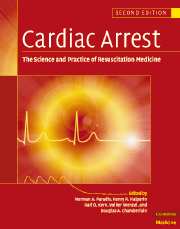Book contents
- Frontmatter
- Contents
- List of contributors
- Foreword
- Preface
- Part I Introduction
- Part II Basic science
- Part III The pathophysiology of global ischemia and reperfusion
- 12 The etiology of sudden death
- 13 Global brain ischemia and reperfusion
- 14 Reperfusion injury in cardiac arrest and cardiopulmonary resuscitation
- 15 Visceral organ ischemia and reperfusion in cardiac arrest
- 16 Mechanisms of forward flow during external chest compression
- 17 Hemodynamics of cardiac arrest
- 18 Coronary perfusion pressure during cardiopulmonary resuscitation
- 19 Methods to improve cerebral blood flow and neurological outcome after cardiac arrest
- 20 Pharmacology of cardiac arrest and reperfusion
- 21 Analysis and predictive value of the ventricular fibrillation waveform
- 22 Etiology, electrophysiology, and myocardial mechanics of pulseless electrical activity
- Part IV Therapy of sudden death
- Part V Postresuscitation disease and its care
- Part VI Special resuscitation circumstances
- Part VII Special issues in resuscitation
- Index
15 - Visceral organ ischemia and reperfusion in cardiac arrest
from Part III - The pathophysiology of global ischemia and reperfusion
Published online by Cambridge University Press: 06 January 2010
- Frontmatter
- Contents
- List of contributors
- Foreword
- Preface
- Part I Introduction
- Part II Basic science
- Part III The pathophysiology of global ischemia and reperfusion
- 12 The etiology of sudden death
- 13 Global brain ischemia and reperfusion
- 14 Reperfusion injury in cardiac arrest and cardiopulmonary resuscitation
- 15 Visceral organ ischemia and reperfusion in cardiac arrest
- 16 Mechanisms of forward flow during external chest compression
- 17 Hemodynamics of cardiac arrest
- 18 Coronary perfusion pressure during cardiopulmonary resuscitation
- 19 Methods to improve cerebral blood flow and neurological outcome after cardiac arrest
- 20 Pharmacology of cardiac arrest and reperfusion
- 21 Analysis and predictive value of the ventricular fibrillation waveform
- 22 Etiology, electrophysiology, and myocardial mechanics of pulseless electrical activity
- Part IV Therapy of sudden death
- Part V Postresuscitation disease and its care
- Part VI Special resuscitation circumstances
- Part VII Special issues in resuscitation
- Index
Summary
During CPR, therapy focuses primarily on restarting the arrested heart and ensuring cerebral perfusion. For the splanchnic and renal circulation, the period of CPR represents a time of very low perfusion. When vasopressors are given during CPR in order to increase vital organ perfusion, splanchnic and renal blood flow may come close to zero.
Negovsky and Safar have long maintained that selfintoxication from visceral organ ischemia as a result of cardiac arrest delays or prevents full neurologic recovery and may be a secondary cause of neuronal injury. Nevertheless, the effects of visceral organ ischemia and reperfusion (I/R) on the postresucitation syndrome, which is characterized by a systemic inflammatory response similar to that observed in other systemic inflammatory conditions such as sepsis, are not fully understood.
In the non-cardiac arrest setting, the two major directions of research on visceral organ ischemia are the contribution of individual visceral organs to development of secondary organ dysfunction and multiple organ failure; and studies of visceral organ injury, surgery, or transplant-ation resulting in or requiring ischemia. This chapter reviews the mechanisms of ischemia and reperfusion injury of the visceral organs; puts them in the context of cardiac arrest, the period of resuscitation (CPR), and the postresuscitation period; and considers how visceral organ ischemia may contribute to the postresuscitation syndrome.
Splanchnic circulation
Splanchnic circulation refers to the vasculature that brings blood to and from the major abdominal organs including the liver, spleen, stomach, pancreas, and small and large intestine.
- Type
- Chapter
- Information
- Cardiac ArrestThe Science and Practice of Resuscitation Medicine, pp. 298 - 325Publisher: Cambridge University PressPrint publication year: 2007

